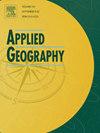Spatial accessibility to healthy food in context: Adapting current conceptualizations to a Latin American city
IF 5.4
2区 地球科学
Q1 GEOGRAPHY
引用次数: 0
Abstract
The study aimed at conceptualizing adequate spatial accessibility to healthy food in Montevideo. The conceptualization was developed following three key steps: i) analysis of observational data on food purchasing behavior, ii) development of an initial definition, iii) validation and refinement with key local stakeholders. Primary data was obtained from a telephone survey with 505 residents to explore food purchasing patterns. Secondary data corresponded to surveys on household expenditure surveys and mobility. Observational data highlighted the diversity of food outlets where residents of Montevideo purchase their food. Small neighborhood stores were identified as key sources of healthy foods, especially for residents of low socio-economic status. Regarding food shopping trips, walking was identified as the main transportation mode. The median travel time was estimated to be 10 min or lower. Areas with adequate spatial accessibility to healthy food in Montevideo were defined as those where residents have access within 600 m to outlets selling all the following food groups: fruits and vegetables, meat, eggs, milk, or culinary ingredients. The methodological approach presented in the current study can be used by other authors to adapt current conceptualizations of spatial accessibility to healthy foods to their local context.
健康食品的空间可达性:适应拉丁美洲城市的当前概念
该研究旨在概念化蒙得维的亚健康食品的充足空间可达性。概念化是通过三个关键步骤发展起来的:1)对食品购买行为的观察数据进行分析,2)制定初步定义,3)与当地关键利益相关者进行验证和改进。主要数据来自对505名居民的电话调查,以探索食品购买模式。二级数据对应于住户开支调查和人员流动调查。观察数据强调了蒙得维的亚居民购买食物的食品店的多样性。小型社区商店被确定为健康食品的主要来源,特别是对社会经济地位较低的居民。在食品购物方面,步行被确定为主要的交通方式。平均出行时间估计为10分钟或更短。在蒙得维的亚,健康食品空间可达性充足的地区被定义为居民在600米范围内可以接触到销售以下所有食品类别的商店的地区:水果和蔬菜、肉类、鸡蛋、牛奶或烹饪原料。本研究中提出的方法方法可以被其他作者使用,以使健康食品的空间可达性的现有概念适应当地的情况。
本文章由计算机程序翻译,如有差异,请以英文原文为准。
求助全文
约1分钟内获得全文
求助全文
来源期刊

Applied Geography
GEOGRAPHY-
CiteScore
8.00
自引率
2.00%
发文量
134
期刊介绍:
Applied Geography is a journal devoted to the publication of research which utilizes geographic approaches (human, physical, nature-society and GIScience) to resolve human problems that have a spatial dimension. These problems may be related to the assessment, management and allocation of the world physical and/or human resources. The underlying rationale of the journal is that only through a clear understanding of the relevant societal, physical, and coupled natural-humans systems can we resolve such problems. Papers are invited on any theme involving the application of geographical theory and methodology in the resolution of human problems.
 求助内容:
求助内容: 应助结果提醒方式:
应助结果提醒方式:


